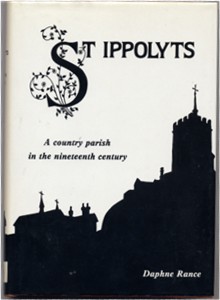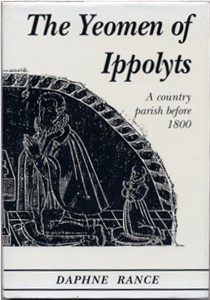
St Ippolyts
A county parish in the nineteenth Century
Daphne Rance
Egon Publishers Ltd, 1987
hardback, 22 cm, v + 214 pages, map, index, and many illustrations.
Our grandparents and great-grand-parents were nineteenth-century people. Their lives were full of the drama of hope and fear and sudden death, of wisdom and ignorance, new inventions and old losses, but for many it was a limited and comfortless time compared to today. Homes, farms, schooling, social conscience and local government all changed remarkably, but Today is built on Yesterday's foundations. [Book cover]
Map of the Parish 6
CHAPTER I The Reverend William Lax and his new parish 9
CHAPTER II Isaac Newton's Observatory. Caring for the Poor 18
CHAPTER III Enclosure of the Common Fields, and a Riot 26
CHAPTER IV Increased population reduces the standard of living 34
CHAPTER V The Lax family and their butler. Another Riot 46
CHAPTER VI Parish Roads. The adventurous Mr Curling 56
CHAPTER VII The Reverend Thomas Steel. Workhouse and School 62
CHAPTER VIII Cholera epidemic. The coming of the Railway. The parishioners in 1851 81
CHAPTER IX Annie Fisher's Journal and the Reverend Fenton Hort's letters 93
CHAPTER X Farmers, Non-conformists, Millers, and Sudden Death 100
CHAPTER XI The Amoses of Stibbs. Woodlands. Policemen 115
CHAPTER XII Restoration of the Church. 'Good Works' and Leisure 124
CHAPTER XIII The Workers. Union Meetings. The 1885 Election 137
CHAPTER XIV Agricultural Depression. Suicide. Arson 150
CHAPTER XV Carriage Folk. Church Life. Miss Augusta Carey 165
CHAPTER XVI Cottage Life at the end of the Century 180
CHAPTER XVII Not All Roses 192
Notes on sources 205
Index 209
| Locating
Books At the time this page was last updated second hand copies were availble online |
 |
|
| Introduction Map of St Ippolyts 1 Thresholds 1 2 The Church in St Ippolyts,1500-1640 14 3 The Church in St Ippolyts,1640-1670 27 4 The Church in St Ippolyts,1670-1750 38 5 The Church in St Ippolyts,1750-1800 48 6 The Manor of Maydencroft 55 7 Widow Cock of Maydencroft 65 8 Maydencroft, 1623-1800 76 9 The Manor of Almshoe Bury 85 10 Little Almshoe 94 11 Brook End 110 12 House Histories 119 13 Working Together 131 14 Millers and Mills and Misdemeanours 145 15 Farmers and Farming 155 16 Medical Matters and Mortality I67 Appendix I77 Index 181 |
|
Daphne Rance
Cortney Publications, 1996
hardback, 22 cm, vii + 184 pages, map and feint line drawings under text,
How did the Civil War affect St Ippolyts? Did King Henry VIII really stay at his manor of Maydencroft for the hunting and did he twice nearly lose his life here? What had Dr. Samuel Johnson to do with this place? You may have thought that history passed this little parish by, but you would be wrong and William the Conqueror's shadow lies across its hills and John Bunyan preached in its hollows.
Perhaps more importantly this is the story of the men and women who lived their whole lives here - the farmers who cultivated the fields of Almshoe Bury and Brookend Farm, the wayward millers of Charlton's Domesday watermill, the carpenters, shoemakers and blacksmiths who kept the village economy running smoothly. Certain individuals are unforgettable, such as the widow Cock of Maydencroft who organised her Elizabethan household magnificently and took burglars and treasure-seekers in her stride, or the meticulous John Hobbs whose mere appearance on somebody's doorstep was apt to set the gossips forecasting a death.Daphne Rance has produced a book that starts by introducing us to Hippolytus the scholar-priest of the third century B.C. to whom the church is dedicated and then leads us through the houses and farmyards of the yeoman families who were the backbone of St Ippolyts in the 16th, 17th and 18th centuries together with the whole range of their neighbours - the poor, the priests, and the apothecaries. By the end of it we feel we really know what it was like to live in this country parish before 1800. [Book cover]
| Locating
Books At the time this page was last updated second hand copies could be ordered online |
Page updated August 2010
